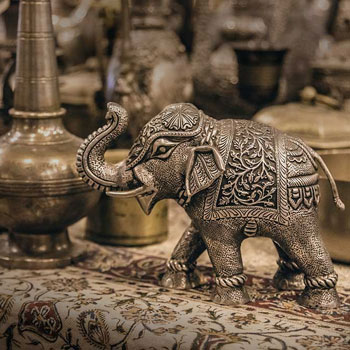Exploring the Rich Heritage of Bidri Craft: Telangana's Timeless Metal Art

Bidri, one of India's iconic metal crafts, is prominent in the region of Bidar, close to Hyderabad. This art form involves intricate inlay or overlay designs on metal, rooted in traditions that date back to the 13th century. Historians note that Bidri craft was introduced by Persian artisans who settled in Bidar during the Bahamani and Baridi Sultanates. Initially, these products graced the palaces of royal sultans and the homes of affluent merchants, with the craft's origins tracing back to 7th-century Persia and Iran.
Have you heard of Gun Metal? It's a metallic blend of copper and zinc primarily used in Bidri craft, occasionally enhanced with lead to improve the polish. The crafting process encompasses various phases such as casting, polishing, engraving, inlaying, and ultimately blackening the metal alloy to accentuate the final design.
References to similar items have been found in central India, where Buddhism and Jainism adopted this style for depicting religious figures in metal artifacts from the 7th century onwards.
Once the initial processing stages are complete, artisans use pure silver for engraving designs onto the molded items. Popular motifs include leaf patterns with three and five points, fish shapes, poppies, and mangoes, reflecting the influence of Persian artistry. Following the polishing phase, the alloy is blackened to enhance the contrast between the bright silver and the dark background.
Even today, the terminology used in this craft retains its Persian origins. For example, the technique of wire inlaying is called "Tarkashi," low relief is "Zarnishan," high relief is known as "Zarbulund," and cut-out designs are termed "Aftabi."
Among the various items produced through Bidri craft, the huqqa has been remarkably popular for centuries, favored by both royal men and women. A painting in the Salar Jung Museum depicts a royal woman smoking a huqqa, highlighting its cultural significance. The museum also houses over 600 exquisite artifacts from this craft.
Bidri crafts include items like flower vases, motifs, religious idols, lamps, home décor pieces, ashtrays, and wall hangings. These items have gained popularity well beyond regional boundaries, admired universally for their exceptional craftsmanship.
When planning your trip to Telangana, consider adding Bidri craft items to your shopping list to acquire a piece of this timeless artistry.
FAQs:
What is Bidri craft and where does it originate?
Bidri craft is a form of metalwork involving intricate inlay designs on metal, originating in Bidar, near Hyderabad. It was introduced by Persian artisans in the 13th century during the Bahamani and Baridi Sultanates.
What materials are used in Bidri craft?
Bidri craft primarily uses a metal alloy called Gun Metal, a blend of copper and zinc, sometimes enhanced with lead. Pure silver is used for the inlay work.
What are the key stages in the Bidri crafting process?
The process involves casting, polishing, engraving, inlaying, and blackening the metal alloy to highlight the designs.
What are some common motifs in Bidri designs?
Common motifs include leaf patterns, fish shapes, poppies, and mangoes, reflecting Persian artistic influences.
Where can one find authentic Bidri craft items?
Authentic Bidri craft items can be found in Telangana and places like the Salar Jung Museum, which houses over 600 exquisite artifacts. These items are also popular in markets for home decor and collectibles.